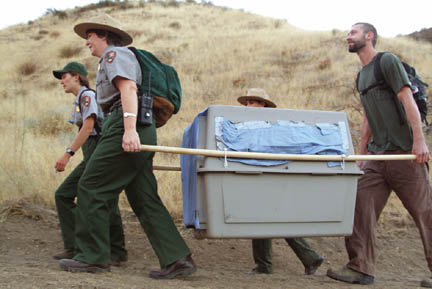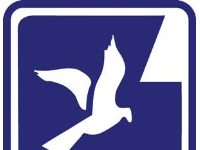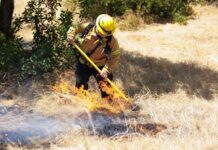
With the species fighting off extinction for a century,
Wednesday’s long-awaited transfer of six California Condors to a
newly built holding pen at Pinnacles National Monument was,
appropriately, a struggle.
But the expectedly treacherous one-mile hike to the site that
included biologists, officials from the park, the U.S. Fish and
Wildlife Service and the Ventana Wilderness Society and students,
was a successful endeavor. The condors were safely placed in a
highly controlled field release pen that had been under
construction for the past six weeks.
With the species fighting off extinction for a century, Wednesday’s long-awaited transfer of six California Condors to a newly built holding pen at Pinnacles National Monument was, appropriately, a struggle.
But the expectedly treacherous one-mile hike to the site that included biologists, officials from the park, the U.S. Fish and Wildlife Service and the Ventana Wilderness Society and students, was a successful endeavor. The condors were safely placed in a highly controlled field release pen that had been under construction for the past six weeks.
Now biologists with Pinnacles and the other agencies will spend the next three months preparing the condors for release into the wild – while taking part in one of the most prominent species reintroduction programs in the world. The condors are between 6 months and 1 year old.
“This is really history in the making for us,” said Park Superintendent Cicely Muldoon, after the condors had been safely placed in their pens. “This is just what national parks are for.”
The release of the condors into the holding facility located in the Grassy Canyon area of San Benito’s scenic treasure took place at about 8:30 a.m. The project has been underway since 1999, while several roadblocks have previously delayed Wednesday’s arrival.
The scavenger species – the largest bird in North America – has been on the federal endangered species list since 1967. The population began declining in the 1890s, reportedly because of hunting and lead poisoning caused by ingestion of ammunition.
California condor conservation efforts have been underway since the early 1980s. While four regions of the world, including Pinnacles Monument and Big Sur on the Central Coast – are currently spearheading reintroduction programs.
A series of recent events led up to Wednesday’s trek up the Pinnacles mountainside. A 20-person crew, that included 15 volunteers, finished constructing the release pen earlier this month.
Late Tuesday night, a team that included Pinnacles condor lead biologist Rebecca Leonard and Ventana Wilderness Director Kelly Sorenson transported the condors from Big Sur.
There, while attempting to capture the condors with hand nets, Leonard received an unwelcome memento; she was bitten twice on a finger and was expected to be given tetanus shots Wednesday afternoon.
The crew, including Leonard, who later called the effort a 24-hour operation, delivered the birds to Pinnacles at about 1:30 a.m.
“Most of us are going on about two hours sleep,” Leonard said Wednesday morning.
Park officials gathered in the darkness of a parking lot at 6 a.m. and recited rules for the trip to the release pen. Seven groups would each carry one condor’s kennel
The containers – 50 pounds with the condors’ added weight – were knee-high, braced by wooden poles along the sides as handles and wrapped by blue cloth to block light and the sight of humans.
Officials instructed people to abstain from talking around or peeking at the condors and asked them to hold the kennels as level as possible, despite the often steep terrain of the dirt trail.
The condors, according to Sorenson, can become extremely stirred by human presence and are also susceptible to overheating.
“You’d think it’d be easy to transport seven birds,” he said.
But it’s not, which was evident by the 200- to 300–yard spacing on the trail of each group, and, even with careful handling, the constant commotion of birds inside the pens.
Completion of the hike for all seven groups lasted about 90 minutes. While the eight students from Monterey area schools carried the final condor.
The students had been awarded the opportunity to take part because they won an essay contest. For any future condor events at Pinnacles, Ventana Wilderness officials said they will try and involve Hollister students.
“Instead of just carrying the condors up a hill, we decided to get the youth involved,” Sorenson said.
After the six condors and an additional 12-year-old mentor condor had been safely placed in the release pen, officials glowed with relief and optimism about the three-month preparation for a release.
Once the condors were in the pen, “they simmered down” and became comfortable, according to Bruce Palmer, U.S. Fish and Wildlife California Condor Recovery coordinator.
Most of the participants in the event witnessed the condor pen arrival from an observation tower located about a quarter mile from the birds’ temporary home.
“It’s so cool!” said Curtis Beriar, a seventh-grader at Monterey Bay Charter School, when he looked through the telescope at the condors outstretching their 9- to 10-foot wing span.
The pen was modeled after those used at Big Sur for its previous condor re-introductions, which have included 33 birds and zero condor fatalities since 1997, according to Sorenson. The base structure is a two-level wooden shelter, while mesh netting surrounds an outdoor enclosure.
The facility, marked throughout by camouflage, is located on the downside of a mountain-top and also includes one-way glass and other amenities for up-close examination by biologists. It, and about 960 acres surrounding the pen, will not be open to the public. And officials have posted signs throughout the area as a warning.
Officials strongly shy away from human contact, for the sake of the condors’ proper development, and even plan to haze the birds with squirt guns and pyrotechnics if condors approach “inappropriate places.”
“We want them to be afraid of people,” said Palmer, who added it helps the mentor bird to “hate people.”
This is just another step, Palmer said, toward reaching some lofty goals for the condor reintroduction program. The agencies plan to continue the program at Pinnacles, with six condors each year until they reach a sustained population of 20.
There are currently 222 California condors in the world, he said, with only 40 free-flying. The program is hoping for an eventual free-flying population of 150, with 15 breeding pairs. Pinnacles, officials said, has the perfect climate and opportunities in the park’s rocky formations for nesting.
“This is a place for condors,” Palmer said.








